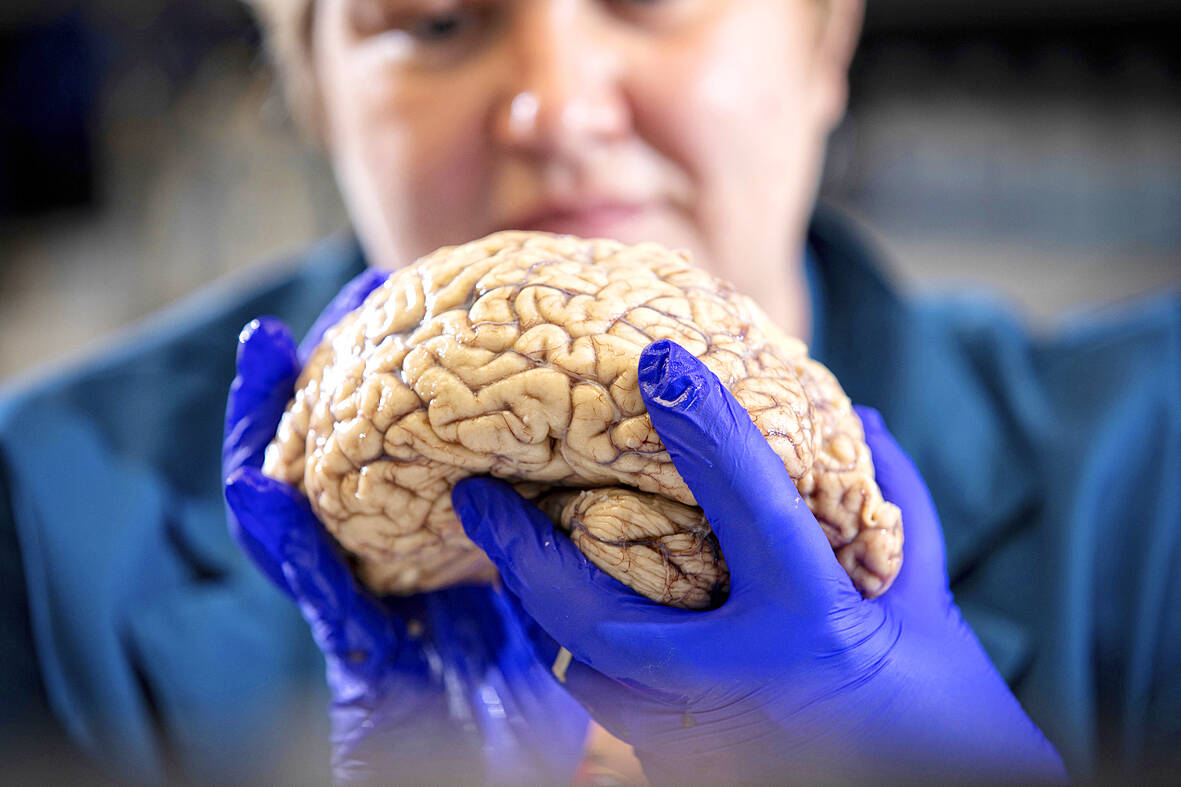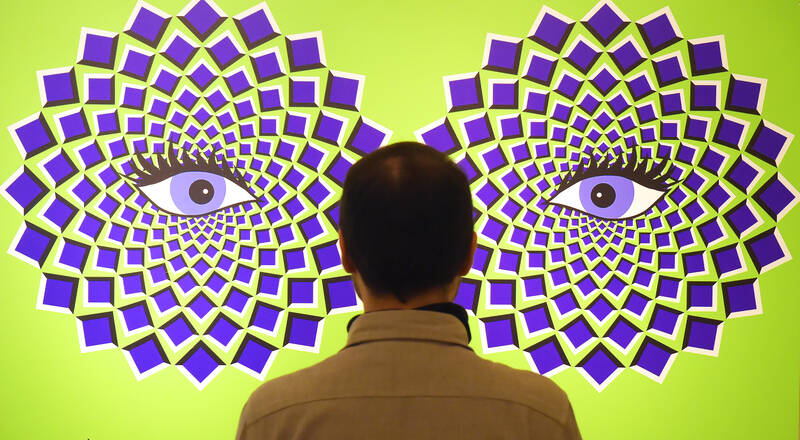In 2018, billionaire Silicon Valley entrepreneur Sam Altman paid a startup called Nectome US$10,000 to preserve his brain after he dies and, when the technology to do so becomes available, to upload his memories and consciousness to the cloud.
This prospect, which was recently popularized in Amazon Prime’s sci-fi comedy series Upload, has long been entertained by transhumanists. Although theoretically possible, it is rooted in the flawed idea that the brain is separate from the body, and can function without it.
The idea that the mind and brain are separate from each other is usually attributed to the 17th-century mathematician and philosopher Rene Descartes, who believed that the body is made of matter, and the mind of some other, non-physical substance.

Photo: AP
Modern brain research rejects the distinction between the physical and the mental. Most neuroscientists agree that what we call “the mind” is made of matter. The mind is hard to define, but the consensus now is that it emerges from the complex networks of cells in the brain.
But most people still view the mind and brain as being distinct from the body. In 2016, four prominent brain researchers published an article summarizing what we know about consciousness. It begins: “Being conscious means that one is having an experience … to see an image, hear a sound, think a thought or feel an emotion.”
It is, however, becoming increasingly clear that the mind/brain and body are intimately linked, and that the body influences our thoughts and emotions. Being conscious does not just mean having awareness of the outside world. It means being aware of one’s self within one’s surroundings. The way we experience our body is central to how we perceive our self.

Photo: AP
PHANTOM LIMBS
Phantom limbs are a striking demonstration of the importance of the body for self-consciousness. They were described in the mid-16th century by the barber-surgeon Ambroise Pare, who reportedly amputated several hundred limbs a day during the Italian war of 1542-46.
“Verily it is a thing wondrous, strange and prodigious,” he wrote. “The patients who have many months after the cutting away of the leg grievously complained that they yet felt exceeding great pain of that leg cut off.” At that time, however, few survived the operation, so the phenomenon was seen only rarely, and dismissed as a delusion.
Advances in medicine and military technology changed this. The invention of a bullet called the Minie ball with its greater accuracy, range and muzzle velocity, increased the number of amputations, while the introduction of anesthetics and antiseptics improved the survival rates of soldiers who went under the knife.
And so it was that the neurologist Silas Weir Mitchell, who amputated countless arms and legs on the battlefields of the American civil war, came to see that phantom limbs are the rule rather than an exception, experienced by the vast majority of amputees.
The medical community was still skeptical of the phenomenon, however, so Mitchell initially described his observations as a short story, “The Case of George Dedlow,” published in the Atlantic Monthly in July 1866. The fictional titular character was a composite of the hundreds of thousands of soldiers who were maimed and mutilated during the conflict. He lost all four limbs, one by one, to become “a useless torso, more like some strange larval creature than anything of human shape,” reduced to “[a] fraction of a man”.
Mitchell’s story was so vivid that readers took it as factual, and believed that he was a real patient being treated at Philadelphia’s South Street “Stump” hospital. Many wrote him letters of support, some tried to visit him and some even raised money for his care. But the story played a large part in bringing the phenomenon into the realms of medical science, and Mitchell went on to become the first elected president of the American Neurological Association.
Mitchell recognized phantom limbs as a disturbance of bodily self-consciousness, in which the amputee retains awareness of the missing limb, and feels as if it is still attached to their body. In some amputees, the phantom disappears within weeks or months of amputation. In others, it persists for decades.
Phantoms do not appear only in the form of missing limbs. Women may experience phantom breasts after mastectomy; men can experience phantom erections after amputation of a cancerous penis; and there are reports of phantom eyes, noses, teeth and even phantom haemorrhoids, bowel movements and gas after surgical removal of the rectum.
BODY INTEGRITY IDENTITY DISORDER
Phantom sensations occur because the brain creates a dynamic model of the body by integrating tactile and visual information with limb position signals from the muscles and tendons. This model, variously called the “body schema” or “body image,” is crucial for both the perception and control of the body. But when a limb or other body part is removed, the schema is not properly updated, and so it retains an imprint of the missing part. As a result, the individual remains conscious of the missing part — often, even more so than of their existing body parts.
Most of us could imagine few things worse than having a limb amputated. But some people want nothing more.
Take Australian Robert Vickers. “Before I was 10 years old I knew my left leg somehow didn’t belong,” Vickers told ABC Radio National in 2009, “and that my body would not be as I felt it should be until I had the leg amputated precisely halfway up the thigh.”
Vickers harbored this strange desire, and suffered in silence, for more than 30 years. It made him severely depressed, and he received psychotherapy. He was prescribed antidepressants, tranquillizers, and antipsychotics, and received electroconvulsive therapy, but to no avail. He tried, without success, to damage his leg in various ways, in order to force an amputation.
Then, at 41, he submerged the unwanted limb in dry ice until the pain became unbearable. His wife drove him to hospital, where he received the amputation he had wanted for so long.
“I left hospital two weeks later with my desired stump, and life changed for the better from that day. In the 24 years since, I only regret not doing it sooner.”
Vickers is perhaps the best documented case of body integrity identity disorder (BIID), an extremely rare condition, of which fewer than 500 other cases have been reported to date. For most of his life, Vickers believed his experience to be unique, but others suffering from the condition describe it in similar terms.
All report a fascination with amputees, and a desire to amputate, from an early age. The desire usually becomes obsessive, to the extent that they will try self-amputation. Use of dry ice appears to be the most common method, and some have used homemade guillotines or shotguns. In another well-documented case, a 79-year-old New Yorker traveled to Mexico and paid an unqualified doctor US$10,000 to amputate his leg. He died of gangrene a week later.
‘AMPUTATION LOVE’
BIID first appeared in medical literature in a 1977 study published in the Journal of Sex Research. The authors of this study — including Greg Furth, himself a “wannabe” amputee — described the condition as a paraphilia, or an abnormal sexual behavior, in which the stump is fetishized because it resembles a phallus, and named it “apotemnophilia,” meaning “amputation love.”
Some BIID sufferers do indeed report a sexual aspect to their desire to amputate. But they invariably describe their experience in terms of self-identity. One participant in Melody Gilbert’s 2003 documentary Whole says that he “finally became a person late in life” after blowing his own leg off with a shotgun. Another participant told the film-makers that “by taking the leg away, I’m actually more of a person than I was before… I’ve corrected the body that was wrong.”
Vickers has stated that he felt incomplete with his left leg, and that he only became “whole” after its removal.
The condition was renamed body integrity identity disorder to reflect this. BIID is a disturbance of bodily self-consciousness with a neurological basis, as are phantom limbs. There is evidence to suggest that it occurs because the affected limb is not incorporated into the body schema as it develops in early childhood. Amputation is not offered as a treatment for BIID sufferers, but it could be argued that making it available to them would minimize their risk of self-harm.
NATURE OF CONSCIOUSNESS
Research into bodily awareness is leading us to rethink the nature of consciousness. Our understanding of how the brain works will progress only when we stop observing the brain in isolation, and start thinking of it as one part of a system that includes the body and its environment.
An understanding of how brain and body interact is critical for understanding the phenomena of phantom limbs and BIID. Such interactions also play a key role in mental health conditions such as anxiety and depression, and in eating disorders such as anorexia nervosa. All of these conditions cause symptoms in the body that may be accompanied by disturbances in how the brain interprets those symptoms.
Yet the links between the brain and body are still under-appreciated. Only by taking the body into consideration will we gain a better understanding of these conditions and, it is to be hoped, develop effective treatments for them.
The new understanding of bodily self-consciousness leads us to some surprising conclusions. If bodily awareness is the basis of self-consciousness, then it follows that bumblebees, and even robots, may possess basic consciousness.
A study published in 2020 by researchers in Germany showed that bees can accurately judge gaps between obstacles relative to their wingspan, and reorient their bodies accordingly to avoid inflight collisions. Researchers at Columbia University’s Creative Machines Lab have developed a starfish-shaped robot with an in-built body schema, which can adjust its gait after having a limb removed. The latest version of this robot creates its own body schema from experience.
If self-consciousness is based in bodily awareness, then it is unlikely that a lab-grown “mini-brain” could ever become conscious, as some ethicists have claimed. By the same token, transhumanists’ claim that we will one day gain immortality by uploading our brains to supercomputers will probably always be science fiction.

Three big changes have transformed the landscape of Taiwan’s local patronage factions: Increasing Democratic Progressive Party (DPP) involvement, rising new factions and the Chinese Nationalist Party’s (KMT) significantly weakened control. GREEN FACTIONS It is said that “south of the Zhuoshui River (濁水溪), there is no blue-green divide,” meaning that from Yunlin County south there is no difference between KMT and DPP politicians. This is not always true, but there is more than a grain of truth to it. Traditionally, DPP factions are viewed as national entities, with their primary function to secure plum positions in the party and government. This is not unusual

Mongolian influencer Anudari Daarya looks effortlessly glamorous and carefree in her social media posts — but the classically trained pianist’s road to acceptance as a transgender artist has been anything but easy. She is one of a growing number of Mongolian LGBTQ youth challenging stereotypes and fighting for acceptance through media representation in the socially conservative country. LGBTQ Mongolians often hide their identities from their employers and colleagues for fear of discrimination, with a survey by the non-profit LGBT Centre Mongolia showing that only 20 percent of people felt comfortable coming out at work. Daarya, 25, said she has faced discrimination since she

More than 75 years after the publication of Nineteen Eighty-Four, the Orwellian phrase “Big Brother is watching you” has become so familiar to most of the Taiwanese public that even those who haven’t read the novel recognize it. That phrase has now been given a new look by amateur translator Tsiu Ing-sing (周盈成), who recently completed the first full Taiwanese translation of George Orwell’s dystopian classic. Tsiu — who completed the nearly 160,000-word project in his spare time over four years — said his goal was to “prove it possible” that foreign literature could be rendered in Taiwanese. The translation is part of

April 21 to April 27 Hsieh Er’s (謝娥) political fortunes were rising fast after she got out of jail and joined the Chinese Nationalist Party (KMT) in December 1945. Not only did she hold key positions in various committees, she was elected the only woman on the Taipei City Council and headed to Nanjing in 1946 as the sole Taiwanese female representative to the National Constituent Assembly. With the support of first lady Soong May-ling (宋美齡), she started the Taipei Women’s Association and Taiwan Provincial Women’s Association, where she